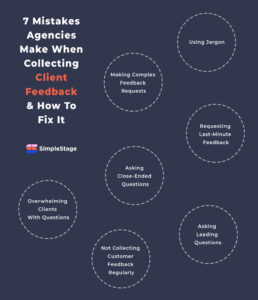
When it comes to collecting client feedback, there are certainly right and wrong ways to go about it. Knowing how to ask for feedback from clients is just as important as making the ask. Unfortunately, many agencies are making critical mistakes when requesting feedback — mistakes that lead to low-quality responses, delays, and confusion. Here’s what you need to know to avoid seven common mistakes that agencies make.
1. Making Complex Feedback Requests
Asking too much of your clients can make the design feedback collection process unproductive. For example, asking for examples of sites your client likes is great — but asking for concrete header image or web page ideas is not. Asking for multi-paragraph responses can also lead to a bad client experience.
Remember: You’re the expert. Your clients may give you suggestions from time to time, but at the end of the day, you should do the bulk of the brainstorming and guide the design process with your knowledge. Ask simple questions that focus on drawing opinions (not ideas) out of your clients.
2. Using Jargon
Unlike your agency, your clients probably aren’t experts in design, development, or content writing. Jargon can make your feedback requests more frustrating than they should be. For instance, if your client has no prior context, words and phrases like “wireframes,” “white space,” and “responsive web design” may confuse them.
Before you send a feedback request to a client, check for any terms that you can simplify. Getting your questions reviewed by a team member or friend who isn’t a design expert can help you learn how to ask for feedback from clients.
3. Asking Close-Ended Questions
Valuable client feedback is never a one-word response. You want your clients to elaborate on their thoughts and provide suggestions for improvement. Unfortunately, close-ended questions tend to elicit one-word answers.
Instead of asking yes-no questions or questions with limited choices (“Do you prefer blue, red, or green?”), opt for questions that encourage a thoughtful response. Instead of asking clients if they like a design element, ask clients what they like or dislike about it.
If all else fails, ask why. “Why?” is a magic question that can make most closed questions open.
Looking for a way to improve the way your agency collaborates with clients and stakeholders?
SimpleStage is the only platform that unifies the client experience by providing tools to help agencies collect content, feedback and track bugs.
Learn More4. Asking Leading Questions
When you ask a leading question, you’re prompting users to respond with your desired or expected answer. Leading questions can put words in your clients’ mouths. For example, “Do you prefer the original version or the improved design?” can sway your clients toward the new version of your website design.
To encourage more genuine answers, focus on asking unbiased questions. Avoid using positive or negative adjectives to describe your website features whenever possible.
5. Requesting Last-Minute Feedback
Much like your agency, your client has deadlines to hit and schedules to follow in their day-to-day work life. When you ask for last-minute feedback, you can completely disrupt the flow of their week. Setting tight deadlines can lead your client to:
- Fully rearrange their schedule to accommodate your feedback request
- Rush through feedback to check it off their to do list
- Submit late feedback
- Not submit any feedback at all
There’s no winning here. You’ll fall behind schedule, get low-quality feedback, or inconvenience your client, which means your customer experience will take a hit.
To improve your feedback collection process, communicate your milestone requirements from the start of the client relationship. Hash out a detailed timeline that includes feedback due dates before you start working on a site. Setting expectations is key.
Then, as your project begins, send reminders of upcoming due dates alongside your weekly client updates. This way, clients won’t be surprised by deadlines, even if they don’t have due dates in their calendars.
6. Not Collecting Customer Feedback Regularly
During the design process, your site can undergo hundreds of changes in the course of two weeks. If your clients only see the beginning and end results, the amount of changes can be overwhelming — they won’t know what to review first. Plus, your clients won’t be able to stop you before you take a completely wrong direction. If clients are dissatisfied, you’ll need to waste a lot of time backtracking or even start from scratch.
Collecting customer feedback regularly — at least once per week — can help you avoid wasted time. With real-time feedback software like SimpleStage, requesting regular feedback can be as simple as uploading a design, so getting frequent responses is far more doable.
7. Overwhelming Clients With Questions
Understanding how to ask for feedback from clients isn’t just about learning the right answers to ask. You also need to condense the amount of questions you send. No one likes their inboxes flooded with dozens of questions to respond to. And when clients are overwhelmed, the quality of their responses to each question may decline.
To limit the amount of questions you ask, start with a list of broader questions that can cover all the must-knows. Then, if you still need more information, follow up.
Collecting customer feedback on a regular basis can also help you shorten your list of questions. Since there won’t be as much to review at once, clients can put their full effort into the questions you prepared for them.
Start Collecting Customer Feedback Effectively
Learning how to ask for feedback from clients is an essential part of every agency’s design process. However, feedback requests aren’t always as straightforward as they seem. To get high-quality responses, you need to ask open questions that are easy to understand and stick to a schedule that works for you and your clients.

